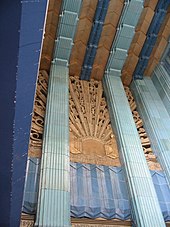Art Deco

Terracotta Art Deco sunburst design above front doors of the Eastern Columbia Building in Los Angeles; built 1930.
The Art Deco style began in Europe in the early years of the 20th century, with the waning of Art Nouveau. The term "Art Deco" was taken from the Exposition Internationale des Arts Decoratifs et Industriels Modernes, a world’s fair held in Paris in 1925.[28] Art Deco rejected many traditional classical influences in favour of more streamlined geometric forms and metallic color. The Art Deco style influenced all areas of design, especially interior design, because it was the first style of interior decoration to spotlight new technologies and materials.[29]
Art Deco style is mainly based on geometric shapes, streamlining, and clean lines.[30][31]The style offered a sharp, cool look of mechanized living utterly at odds with anything that came before.[32]
Art Deco rejected traditional materials of decoration and interior design, opting instead to use more unusual materials such as chrome, glass, stainless steel, shiny fabrics, mirrors, aluminium, lacquer, inlaid wood, sharkskin, and zebra skin.[29] The use of harder, metallic materials was chosen to celebrate the machine age. These materials reflected the dawning modern age that was ushered in after the end of the First World War. The innovative combinations of these materials created contrasts that were very popular at the time - for example the mixing together of highly polished wood and black lacquer with satin and furs.[33] The barber shop in the Austin Reed store in London was designed by P. J. Westwood. It was soon regarded as the trendiest barber shop in Britain due to its use of metallic materials.[32]
The color themes of Art Deco consisted of metallic color, neutral color, bright color, and black and white. In interior design, cool metallic colors including silver, gold, metallic blue, charcoal grey, and platinum tended to predominate.[30][34] Serge Chermayeff, a Russian-born British designer made extensive use of cool metallic colors and luxurious surfaces in his room schemes. His 1930 showroom design for a British dressmaking firm had a silver-grey background and black mirrored-glass wall panels.[32][35]
Black and white was also a very popular color scheme during the 1920s and 1930s. Black and white checkerboard tiles, floors and wallpapers were very trendy at the time.[36] As the style developed, bright vibrant colors became popular as well.[37]
Art Deco furnishings and lighting fixtures had a glossy, luxurious appearance with the use of inlaid wood and reflective finishes. The furniture pieces often had curved edges, geometric shapes, and clean lines.[28][32] Art Deco lighting fixtures tended to make use of stacked geometric patterns.[38]
Modern Art
"Modern design grew out of the decorative arts, mostly from the Art Deco, in the early 20th century."[39] One of the first to introduce this style was Frank Lloyd Wright, who hadn't become hugely popularized until completing the house called Fallingwater in the 1930s. "Modern art reached its peak in the 1950s and 60s which is why designers and decorators today may refer to modern design as being "mid-century."[39] Modern Art does not refer to the era or age of design. "Modern art is not the same as contemporary design, which is a term that interior designers apply to a shifting group of recent styles and trends."[39]
Comments